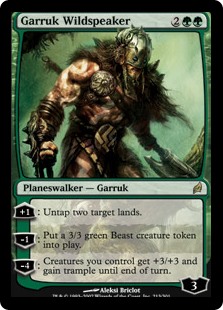
Planeswalkers have been around for a long time now and we are well aware that they are good and why they are good. Versatility, value, and threats are generally the common answers to the why question. The more I play with walkers however the more I think we overlook a significant element of their play. It was actually the introduction of Saga cards that made me properly realize the power this element of planeswalkers offers. Magic is so well balanced these days that mana advantage counts for so much outside of the properly powered up formats like vintage. So much so that it is not just the total amount you spend over a game but also the amount on any given turn. If I do four mana's worth of stuff on turn three then I get a pretty big tempo edge out of that which I can ride far deeper into the game even if I have no real edge on mana beyond this one turn spike. Mana above what you should usually have relative to your opponent is typically worth more than normal. Basically planeswalkers and saga cards both do things once deployed for no mana cost which means you are gaining the effect of having ramped your mana. You get to do your normal stuff with your actual mana but also get that extra boost so as to swing the tempo in your favour. Now obviously both walkers and saga have an initial tempo hit where the return you get on the first turn is lower than what you might expect for the cost but if you can make that work then the following few turns are going to be really good to you.
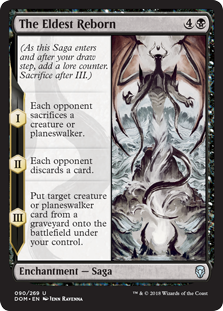
The card where this was most noticeable was The Eldest Reborn. The third age was such a powerful effect that being able to do it and your whole normal turn was often just unrecoverable. It was like having a Time Walk or having a personal Mana Flare. Deploying a big threat as a midrange or control player is often risky but if you can do that and something else it is game ending. The number of times you just get the best card from either deck and sit back on double counterspell, or get back a planeswalker that kills their walker and Wrath as well. The Eldest Reborn is not powerful because of the sum of it's parts so much as it is presented. If you swapped the effects around such that the last one always came first it would be a far weaker spell in most cases in the cube despite seeming like it was better due to being more front loaded. Even something more direct like History of Benalia has perks that come with the delay. It would be more damage if both knights came at once but it would also make it far easier to handle sensibly with mass removal. A white aggro deck curving out with this is far less likely to eat a Wrath effect when age II is yet to hit. This can really upset how your opponent curves and can easily cause them to take a load of free damage or fail to safely deploy a planeswalker of their own.
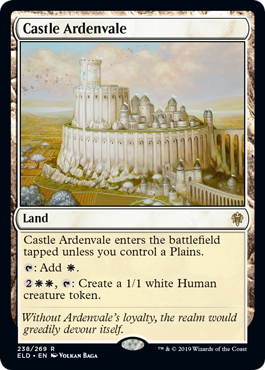
Planeswalkers have this same saga like effect on the game although it is not quite so predetermined or reliable an outcome. This obviously is better in some cases and worse in others. You can generally assume your saga card will play out and thus know what your gains will be and when while a walker might live all game or die the next turn. Assessing expected returns on any front for walkers is just conjecture.
For this article I just want to look at mana returns which is a bit odd. It is proving quite tricky removing the card advantage element from the equation. We all know that over time almost all planeswalker provide real or effective card advantage and will ultimately dominate the game. My aim is to show that it is significantly also the aspect of the mana returns of the cards that lead to them taking over.
Now it is pretty easy to equate the value of an effect of a planewalker to a mana cost as we typically have spells that mirror the abilities. The reality is however much more complicated and where I got into so much difficulty thinking of walkers just in mana terms. Basically there is a huge difference between the value of an effect when played as a spell that costs you a card to do and one on a card already in play. One mana for a 1/1 token seems like a pretty poor deal when it is a Lab Rat (without buyback). Paying 2WW(W) to activate Castle Ardenvale however seems far more reasonable.
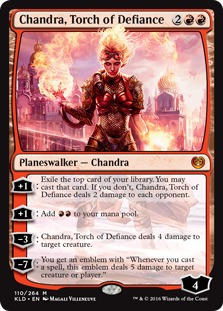
Planeswalkers have a very different way of scaling and balancing to spells. Things that reliably generate card advantage are much more expensive in loyalty terms, as are effects that protect the planeswalker in question. Things that fail to generate card advantage, reliably or at all, will be much more generously costed. It used to seem as if the significant abilities were just cost at -X lotyalty where X is equal to the fair cost of that effect while +loyalty abilities were much more commonly the kinds of thing you wouldn't play on a dedicated card as it was too low power or situational. As planewalker understanding has deepened and design has diversified we find this measure holds true less than it did even if it remains a reasonable starting point for balance consideration.
A good showcase for this pattern is on Chandra, Torch of Defiance. She has a -3 which is Flame Slash which costs 1 mana normally and a +1 which affords a gain of RR which is closest to Seething Song which is a three mana card. The huge discrepancy there between costs of loyalty can mostly be explained with the logic that Flame Slash reliably affords card advantage and protects Chandra while Seething Song does neither. There is also the mild kicker that Seething Song loses instant speed when on Chandra, it cannot burst mana from 3 being on a four drop, nor on the turn it is played as it is still leaving you at -2 mana for the turn and really needs three activations before you are at +2 mana on initial investment. That is a bit of an unimportant tangent, in practice all turns after the first the +1 is effectively a Seething Song and for the most part we will be considering turns after planeswalkers are played. That is when they really start to dominate games. The ones that come down, do one good thing and then die to removal or attacks are the fair norm. Sometimes that is good, sometimes it is a little below par but it is never a thing that dominates nor ever a thing that allows you to do more manas worth of stuff on a turn than you have mana for.
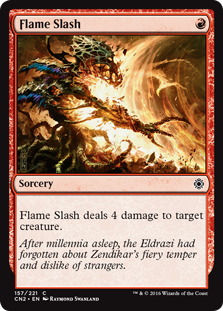
Another thing that makes planeswalker ability costs hard to quantify is that gain and loss of loyalty is a thing in itself. Loyalty can equate to gaining of life when it is diverting attacks away from face. It can be a way of protecting the walker. It can be a way of storing up value so you can blow it later on high value effects with high loyalty costs. The value of changing loyalty on a planeswalker depends on so much. The board state, the current loyalty, your current life total, the abilities on the planeswalker both in terms of cost and effect. Trying to slap a generic mana cost to loss or gain of loyalty is near impossible. Even a range was pretty hard to estimate. The average is pretty unreliable of a thing to try and estimate too due to outliers pushing it away from a reasonable value. Suffice it to say that loyalty is worth a little more on more powerful planeswalkers and a little less when you are on low life. There are little spikes in value when you pass a point on a walker where by you can subsequently activate a new negative loyalty ability where loyalty is worth more than it was before. With Chandra, Torch of Defiance having a -3 ability we can say that all other things being discounted that the 3rd and 4th loyalty are worth marginally more than the 2nd or 5th. The 3rd allows for use of the -3 while the 4th allows for use and still having a Chandra hence why there are these two steps. Mostly use and survive is the more valuable loyalty but not always. There are also the board and matchup specific conditions. When facing down a 2/2 dork your 3rd loyalty is more valuable than the 2nd. If you know they have a lot of 3 damage spells then the fourth loyalty holds extra value and so forth. Loyalty often feel like they are worth a life or a mana a pop but given how infrequently a life is worth a mana it is more clear how this is a problematic thing to try and get mathsy with. When spending loyalty it feels like you are spending life to gain mana and cards while when gaining loyalty it more typically just feels like gaining mana and life. As you can see, with this perspective simply activating a planeswalker, regardless of the gain or loss in loyalty or card advantage it has the effect of gaining mana to some degree.
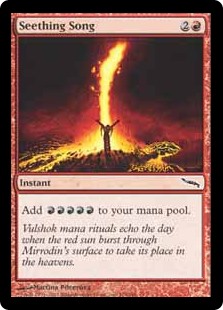
With this in mind we can start to consider how quickly planeswalkers return their worth in mana costs alone as each turn they are in play they generate some "mana back" value. This does need looking at on a case by case example due to all the different costs, effects and starting loyalty differences but it is a lot easier with a solid framework in play. While working through the logic on these models for evaluating planeswalkers I kept finding places where I was accounting for a cost or bonus twice. An example of that would be any mana producing ability on a planeswalker. If we look at Torch of Defiance again and imagine that her +1 is a Seething Song we can say it is worth 3 mana but then we might be tempted to also add a further two mana to that total as we have still got that two mana but this is counting it as double. It either makes two mana or is worth three based on the cost of the most comparable spell. Being that much less abusive than the spell iteration I would certainly be inclined to consider this +1 ability to equate to two mana of value! You know, what with that being exactly the case and all! Just nice to know it does check out with the other means of assessing. You do also gain that psuedo life with the loyalty gain as well! The same applies to many tempo spells. The spell cost is the starting point. In the case of the Flame Slash mode it is the floor, in reality you can kill anything upto about a five drop with it. If you did so then the real mana advantage is paying for Chandra immediately! This is also a situational upper case, we are mostly looking at averages. The average price of something you kill with a Flame Slash is probably closing on 3 mana meaning you are probably looking at about that for your mana gain for the average case. If I had to go with whole number I would likely round down to two mana but would prefer to think of it as around 2.5 in gain. The large loyalty loss is still a cost. Broadly speaking the tempo spells that protect your walker are worth a little more in estimated mana terms than the cost of the real spells when on walkers and the "spell cost evaluation" is the floor. Those without a direct tempo component tend to be the other way around as per the Seething Song going from a 3 to a 2 when looked at more practically. Despite Seething Song indirectly affording tempo you need things to pair with it in order that it does anything useful while the Flame Slash works to protect all by itself. This is just the scaling of effects on walkers I discusses earlier but transferred into the more meaningful metric of mana values.

As you can probably now see clearly, Chandra pays for herself very quickly and affords big swing potentials and this helps to explain why she is such a powerful card. You can be mana neutral with her on the following turn to playing her, with an extra two loyalty and all the benefits of having a turn of burst mana as well. Flameslash into Seeting Song is also paying for herself in mana terms in two turns on average pretty comfortably as well. Very few walkers come close to paying for themselves so quickly and with so much power and flexibility as Chandra does. Consider Jace the Mind Sculptor, one of the best on offer as a comparison. Brainstorm is a one mana spell but it is potent and undercost so we can more reasonably consider it to be worth closer to two mana even without any tempo component. Unsummon also compares reasonable well in tempo terms to Flame Slash and probably equates to a two or three mana gain in practice. Unsummon hits more things and is also usable back to back unlike Candra's Flame Slash. The downside is in being bad against good EtB effect dorks and not providing card advantage which are both things we care less about in this discussion. Another perk of the Unsummon mode is that you get two loyalties worth with a single +2 while it takes three turns of charging up a -3 on Chandra. All somewhat minor when looking at the mana gain but still well worth considering when trying to evaluate and compare. So both Jace and Chandra have a variety of ways in which they can pay for themselves in two activations. Chandra can leave herself in a better state or provide bigger swings in doing so but they line up fairly well. A reasonable measure of a good planeswalker is one that pays for itself purely in mana terms in two turns with some degree of flexibility. Unsummon and Flame Slash are both undercost effects on their respective cards as both are situational. Dedicating a card and a deck slot to them is a big cost in itself. Transitioned over to an option on a planeswalker and the effective mana value clearly shoots up along with the increased relevance of the effects given what they are protecting as well as what they are not costing you in deck construction terms.
Garruk Wildspeaker is a nice clean example of this too with both his +1 and -1 equating to about two mana worth of effect. He has even greater degree of flexibility as he ultimate is more readily accessible. He can +1 and -4 over two turns which is more like 7 mana worth of value! This means Garruk has 4 different combinations of abilities that result in four or more manas worth of value being returned in two activations. Garruk is very good but he is not a premium walker any more these days. Mana return and options on getting those returns are a great metric for assessing walkers but it is not something you can use exclusively. Garruk loses value in ways not accounted for just by looking at mana. His +1 and -4 are both contingent on you having things to do with them and his -1 is very bland. A 3/3 token for 2 mana is decent because it is a potential early play, a 3/3 token loses some value as the game goes on. It is also not direct card advantage, tokens are easily and often swept away with little to no extra cost. There is no disruptive element to Garruk either all of which means that despite Garruk having one of the better results of walkers looked at in mana terms he doesn't quite make it into that top tier bracket any more.

Let us now try and use this methodology to explain why Dack Fayden is such a polar planeswalker. To pay for himself with the +1 ability he needs three activations what with Careful Study being a one mana effect. With the -2 however you generally get a pretty solid 4+ mana worth back. Steal Artifact is a four mana spell as baseline. Taking a Signet is two mana worth of your opponents stuff they lose and you gain which is also a four mana swing. Steal a Wurmcoil and you have a 12 mana swing! Basically Dack is below the power level of good walkers when unable to use the -2 ability and quite significantly better pretty much whenever he can, certainly on average. Obviously also when you take card advantage into consideration this polarization is further more apparent what with three iterations of the +1 affording no card advantage while a single use of the -2 affording a two for nothing. Dack doesn't even have a good ultimate meaning without the use of the -2 the value of his loyalty gains are rather diminished too.
Another trick you can use to sniff out potentially busted planeswalkers simply in terms of mana advantage are those with +loyalty abilities which are on point mana wise but scale nicely with planeswalkers. Liliana the Last Hope is a great example of this. So she can Corpse Churn for -2 which is reasonably a two mana ability or she can -2/-1 something which is close to a one mana ability. Now, in order for us to to make back three mana in two turns we would need at least one -2 which given the starting loyalty of 3 means we can only do this in on way, a +1 and a -2. Just using that as a measure you would conclude Torch of Defiance and Mind Sculptor to be better but we have multiple mitigating factors. Firstly the bar is lower for cheaper walkers and higher for more expensive ones. A three mana walker can get to work sooner and thus have activated three times it would take a four mana one to activate twice. It also allows needs to defend against weaker aggression.You can even argue that four mana non-walker spells are a significantly more impactful than three mana ones when compared to walkers in the 3 and 4 mana brackets. A three mana walker followed by a four mana spell should swing the game more than a three mana spell followed by the four mana walker. The more relevant mitigating factor however is that you can gain both tempo and card advantage from the +1 on the Last Hope. Recall how both these effects scale much better with having a planeswalker in play. If you flop out Last Hope and kill the only thing in play that threatened it, or even just a mana elf that has pulled you so far a ahead. Yes, one turn cycle of Weakness is far weaker protection than Unsummon or Flameslash but it is on a + ability not a - one which makes it vastly more threatening. You don't need to kill things with it for it to be good. Just building up loyalty to spend while calming the board is good, assuming that is you have useful ways to spend that loyalty such as a game winning ultimate or a value generating - ability as per Last Hope. Basically the Last Hopes +1 ability is very much one that I would normally expect to find with a -loyalty cost. It is disruptive and can well kill or neuter things around the 3 CMC mark. This potential to scale is all rather dangerous on a +ability of a three mana walker!
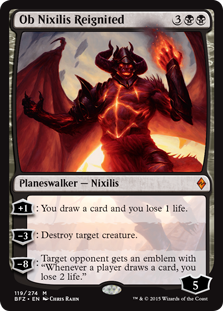
We can use explain why a planeswalker is weaker than others by mana return analysis too. Ob Nixilus, Reignited is the weakest planeswalker I find in my cube with any regularity. The +1 is worth a mana and while it might generate value it does not generate any tempo. Only the -3 Murder affords tempo and while it is worth three mana there is no way of using it twice in two turns. As such it takes three turns for Ob to pay for himself in mana terms and even that comes with no flexibility beyond sequencing. Ob scrapes a pass by reliably being at worst card neutral and by having some pretty clean and desirable effects. You could drop him a mana in cost and a starting loyalty however and turn him into a very good planeswalker. He would look a lot more like Vraska Golgari Queen then!
Planeswalkers are good not just because they provide flexiblity, card advantage and threats but because they provide a pseudo ramp effect as well. The better walkers tend to be able to pay for themselves in two turns roughly and become mana positive three activations in and onwards. The best of those are ones with versatility on how you can quickly get into the positive with mana for them and those that can do the most potent and useful things while growing, basically it is context all the way once you have considered the mana elements. Recall my initial claim about most early walkers having a plus that feels like gaining mana and life and a minus that feels like gaining mana and card advantage? Those that have a +ability like Liliana the Last Hope can feel like they are gaining mana, life, and card advantage all at the same time which is of course made of winning. Scaling potential is the other big winner for abilities assuming a decent floor or sufficient alternative options. Garruk's +1 is almost always worth two mana but is often worth more when you have lands tapping for multiple mana in play. Torch of Defiance on average returns about four mana in two turns with the mana and the -3 but she can get way more if she manages to hit the right thing!

There are some walkers that can essentially pay for themselves immediately. Serra the Benevolent comes very close with a 4/4 Serra Angel token. There are of course all those that can do based on the situation and scaling potential such as Torch of Defiance, Dack Fayden and even Ajani Goldmane! Some that more reliably return a little more than investment over two turns. Mu Yangling, Sky Dancer and Teferi, Hero of Dominaria both feel like they fairly reliably return more mana's worth than invested by the second activation all be it not by much. The two cards that standout as being ones that pay for themselves fastest are unsurprisingly those with static effects. Teferi Time Raveler has a Repulse mode which is worth three mana as a baseline and has some potential to scale up in mana returns as well. The static ability on Tef is worth about two mana and so right away you have upto five mana worth of value from the get go. Narset Parter of Veils is similarly brutal, her -2 is basically Peer Through Depths, you could argue the case for it being a one mana ability but it would be a very very good one at that! Even if we compromise and call it 1.5 the static ability is worth at least 2, probably more like 2.5 mana. In two turns Narset has nearly paid for herself twice over and does so right away too! Luckily she has no means to defend herself or grow in loyalty and is locked to two activations by herself which somewhat limit her capacity to get out of hand. Still, front loaded is what you want on planeswalkers where possible and Narset does that amazingly well.
When faced with a new walker to evaluate try and estimate what each (non-ultimate in most cases) ability is worth in terms of mana and as such which possible two and three activation sequences are possible and roughly how much mana they return. Then look at how much protection, card advantage and tempo they afford and you will have a reasonably good picture of the value of the card compared to other walkers. Obviously you need to account for both scaling potential of the abilities and how situational they are as well. If we always have a lot of dorks in play Ajani Goldmane is pretty impressive as the -2 scales well but if not he is awful because the +1 is low value and the -1 is poor. So while there are no perfect methods for assessing the value of planeswalkers it does seem as if one of the most consistent and indicative of power is the rate of mana investment return. Value is nice and important and all but most of the relevant portion of the game of magic is fought when both players have cards to choose from and mana is the limiting factor. By that logic alone the most relevant factor for a good planeswalker should be the ways in which they increase your effective mana spending.
 I started this exercise in an attempt to demonstrate the difference in value between token and non-token creatures but it failed to really help with that problem as I had hoped. All the exercise really did is further prove to me that the value of a card is entirely based on context. While I cannot easily put a value on a card I can perhaps at least convince you that part of the value of drawing a card has absolutely nothing to do with what that card is or does. I was going to use near blank cards like Darksteel Relic or Spellbook as my example of a blank card but the issue there is that you can have all sorts of uses and synergies for those things and that all rather muddies the waters. Instead I designed this card which is simply a reworking of Ancestral Recall such that it only draws effectively dead cards. It is not quite perfect in that it doesn't trigger actual drawing effects and wouldn't trigger an opposing Consecrated Sphinx. I am sure I could add wording to allow for such things but the card is already on the wordy side. The point is that this card is clearly pretty good and would likely see play in a lot of formats. If all this does is draw you dead cards in hand and yet still seems good then it is clear that cards in hand is a valuable resource, regardless of what they do or do not do themselves. Almost like how life points all do nothing for you barring the last one. Ancestral Illusions doesn't even help with things like Ivory Tower triggers or provide a great pool of unknowns for your opponent as three actually dead cards in hand would do. Mostly what this does is turn your loot effects into draw effects for a bit. It lets you power up your Collective Brutality. It is not even useless when you don't have effects that work with discarding cards from hand as it protects against things like Blightning.
I started this exercise in an attempt to demonstrate the difference in value between token and non-token creatures but it failed to really help with that problem as I had hoped. All the exercise really did is further prove to me that the value of a card is entirely based on context. While I cannot easily put a value on a card I can perhaps at least convince you that part of the value of drawing a card has absolutely nothing to do with what that card is or does. I was going to use near blank cards like Darksteel Relic or Spellbook as my example of a blank card but the issue there is that you can have all sorts of uses and synergies for those things and that all rather muddies the waters. Instead I designed this card which is simply a reworking of Ancestral Recall such that it only draws effectively dead cards. It is not quite perfect in that it doesn't trigger actual drawing effects and wouldn't trigger an opposing Consecrated Sphinx. I am sure I could add wording to allow for such things but the card is already on the wordy side. The point is that this card is clearly pretty good and would likely see play in a lot of formats. If all this does is draw you dead cards in hand and yet still seems good then it is clear that cards in hand is a valuable resource, regardless of what they do or do not do themselves. Almost like how life points all do nothing for you barring the last one. Ancestral Illusions doesn't even help with things like Ivory Tower triggers or provide a great pool of unknowns for your opponent as three actually dead cards in hand would do. Mostly what this does is turn your loot effects into draw effects for a bit. It lets you power up your Collective Brutality. It is not even useless when you don't have effects that work with discarding cards from hand as it protects against things like Blightning.